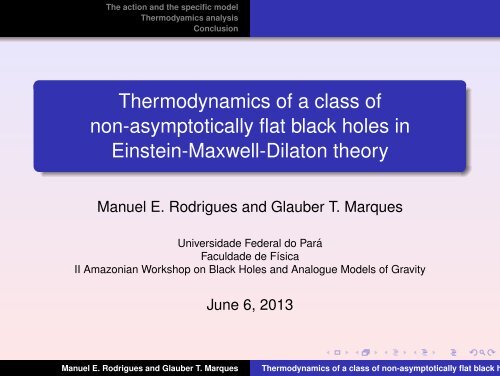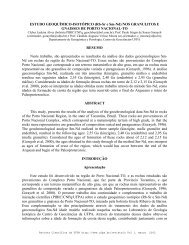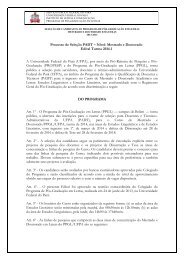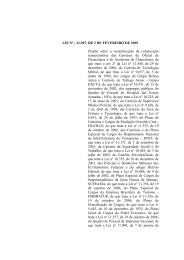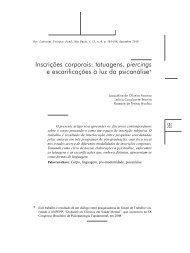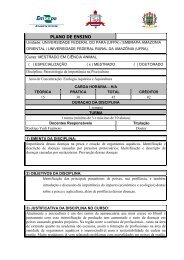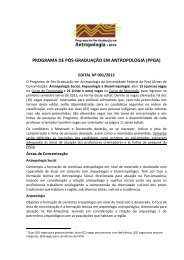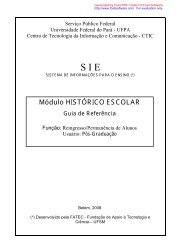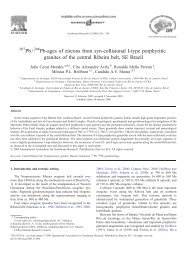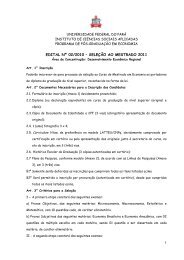Thermodynamics of a class of non-asymptotically flat black holes in ...
Thermodynamics of a class of non-asymptotically flat black holes in ...
Thermodynamics of a class of non-asymptotically flat black holes in ...
You also want an ePaper? Increase the reach of your titles
YUMPU automatically turns print PDFs into web optimized ePapers that Google loves.
The action and the specific model<br />
Thermodyamics analysis<br />
Conclusion<br />
<strong>Thermodynamics</strong> <strong>of</strong> a <strong>class</strong> <strong>of</strong><br />
<strong>non</strong>-<strong>asymptotically</strong> <strong>flat</strong> <strong>black</strong> <strong>holes</strong> <strong>in</strong><br />
E<strong>in</strong>ste<strong>in</strong>-Maxwell-Dilaton theory<br />
Manuel E. Rodrigues and Glauber T. Marques<br />
Universidade Federal do Pará<br />
Faculdade de Física<br />
II Amazonian Workshop on Black Holes and Analogue Models <strong>of</strong> Gravity<br />
June 6, 2013<br />
Manuel E. Rodrigues and Glauber T. Marques<br />
<strong>Thermodynamics</strong> <strong>of</strong> a <strong>class</strong> <strong>of</strong> <strong>non</strong>-<strong>asymptotically</strong> <strong>flat</strong> <strong>black</strong> h
Abstract<br />
The action and the specific model<br />
Thermodyamics analysis<br />
Conclusion<br />
We analyse <strong>in</strong> detail the thermodynamics <strong>in</strong> the ca<strong>non</strong>ical<br />
and grand ca<strong>non</strong>ical ensembles <strong>of</strong> a <strong>class</strong> <strong>of</strong><br />
<strong>non</strong>-<strong>asymptotically</strong> <strong>flat</strong> <strong>black</strong> <strong>holes</strong> <strong>of</strong> the E<strong>in</strong>ste<strong>in</strong>-(anti)<br />
Maxwell-(anti) Dilaton theory <strong>in</strong> 4D with spherical symmetry.<br />
We present the first law <strong>of</strong> thermodynamics, the thermodynamic<br />
analysis <strong>of</strong> the system through the geometrothermodynamics<br />
methods, We<strong>in</strong>hold, Ruppe<strong>in</strong>er, Liu-Lu-Luo-Shao and the most<br />
common, that made by the specific heat. We also analyse the<br />
local and global stability <strong>of</strong> the thermodynamic system<br />
Manuel E. Rodrigues and Glauber T. Marques<br />
<strong>Thermodynamics</strong> <strong>of</strong> a <strong>class</strong> <strong>of</strong> <strong>non</strong>-<strong>asymptotically</strong> <strong>flat</strong> <strong>black</strong> h
Outl<strong>in</strong>e<br />
The action and the specific model<br />
Thermodyamics analysis<br />
Conclusion<br />
1 The action and the specific model;<br />
2 <strong>Thermodynamics</strong> analysis;<br />
3 Conclusion.<br />
Manuel E. Rodrigues and Glauber T. Marques<br />
<strong>Thermodynamics</strong> <strong>of</strong> a <strong>class</strong> <strong>of</strong> <strong>non</strong>-<strong>asymptotically</strong> <strong>flat</strong> <strong>black</strong> h
The action and the specific model<br />
Thermodyamics analysis<br />
Conclusion<br />
The model<br />
The action <strong>of</strong> E<strong>in</strong>ste<strong>in</strong>-Maxwell-Dilaton theory is given by:<br />
∫<br />
S = dx 4√ ]<br />
−g<br />
[R − 2 η 1 g µν ∇ µ ϕ∇ ν ϕ + η 2 e 2λϕ F µν F µν , (1)<br />
where the first term is the usual E<strong>in</strong>ste<strong>in</strong>-Hilbert gravitational<br />
term, while the second and the third are respectively a k<strong>in</strong>etic<br />
term <strong>of</strong> the scalar field (dilaton or phantom) and a coupl<strong>in</strong>g term<br />
between the scalar and the Maxwell fields, with a coupl<strong>in</strong>g<br />
constant λ that we assume to be real. The coupl<strong>in</strong>g constant η 1<br />
can take either the value η 1 = 1 (dilaton) or η 1 = −1<br />
(anti-dilaton). The Maxwell-gravity coupl<strong>in</strong>g constant η 2 can<br />
take either the value η 2 = 1 (Maxwell) or η 2 = −1<br />
(anti-Maxwell).<br />
Manuel E. Rodrigues and Glauber T. Marques<br />
<strong>Thermodynamics</strong> <strong>of</strong> a <strong>class</strong> <strong>of</strong> <strong>non</strong>-<strong>asymptotically</strong> <strong>flat</strong> <strong>black</strong> h
The action and the specific model<br />
Thermodyamics analysis<br />
Conclusion<br />
In order to obta<strong>in</strong> the str<strong>in</strong>gs models, we choose a general<br />
conformal factor<br />
ĝ µν = e −2ωϕ g µν , (2)<br />
The action (1), which is <strong>in</strong> the E<strong>in</strong>ste<strong>in</strong> frame, can be <strong>class</strong>ified<br />
<strong>in</strong>to the three follow<strong>in</strong>g types:<br />
a) Type I Str<strong>in</strong>gs<br />
As we need the usual Str<strong>in</strong>gs models 1 , mak<strong>in</strong>g use <strong>of</strong> the<br />
dilaton case <strong>in</strong> which ω = η 1,2 = 1, λ = 1 2<br />
, the action (1) reads:<br />
∫<br />
S I =<br />
√ { [<br />
d 4 x −ĝ e −2ϕ ̂R + 4ĝ µν ̂∇µ ϕ ̂∇<br />
]<br />
ν ϕ − e −ϕ 2 ̂F } , (3)<br />
1 We could formulate the Str<strong>in</strong>gs models with phantom contribution.<br />
Manuel E. Rodrigues and Glauber T. Marques<br />
<strong>Thermodynamics</strong> <strong>of</strong> a <strong>class</strong> <strong>of</strong> <strong>non</strong>-<strong>asymptotically</strong> <strong>flat</strong> <strong>black</strong> h
The action and the specific model<br />
Thermodyamics analysis<br />
Conclusion<br />
In order to obta<strong>in</strong> the str<strong>in</strong>gs models, we choose a general<br />
conformal factor<br />
ĝ µν = e −2ωϕ g µν , (2)<br />
The action (1), which is <strong>in</strong> the E<strong>in</strong>ste<strong>in</strong> frame, can be <strong>class</strong>ified<br />
<strong>in</strong>to the three follow<strong>in</strong>g types:<br />
a) Type I Str<strong>in</strong>gs<br />
As we need the usual Str<strong>in</strong>gs models 1 , mak<strong>in</strong>g use <strong>of</strong> the<br />
dilaton case <strong>in</strong> which ω = η 1,2 = 1, λ = 1 2<br />
, the action (1) reads:<br />
∫<br />
S I =<br />
√ { [<br />
d 4 x −ĝ e −2ϕ ̂R + 4ĝ µν ̂∇µ ϕ ̂∇<br />
]<br />
ν ϕ − e −ϕ 2 ̂F } , (3)<br />
1 We could formulate the Str<strong>in</strong>gs models with phantom contribution.<br />
Manuel E. Rodrigues and Glauber T. Marques<br />
<strong>Thermodynamics</strong> <strong>of</strong> a <strong>class</strong> <strong>of</strong> <strong>non</strong>-<strong>asymptotically</strong> <strong>flat</strong> <strong>black</strong> h
The action and the specific model<br />
Thermodyamics analysis<br />
Conclusion<br />
b) Type IIA Str<strong>in</strong>gs<br />
For the parameters ω = η 1,2 = 1, λ = 0, the action (1)<br />
becomes:<br />
∫ √ { [<br />
S IIA = d 4 x −ĝ e −2ϕ ̂R + 4ĝ µν ̂∇µ ϕ ̂∇<br />
]<br />
ν ϕ − ̂F 2} . (4)<br />
c) Heterotic Str<strong>in</strong>gs<br />
For the parameters ±ω = η 1,2 = ∓λ = 1, the action (1) behaves<br />
as:<br />
∫ √ {<br />
S H = d 4 x −ĝ e −2ϕ ̂R + 4ĝ µν ̂∇µ ϕ ̂∇ ν ϕ − ̂F 2} , (5)<br />
Manuel E. Rodrigues and Glauber T. Marques<br />
<strong>Thermodynamics</strong> <strong>of</strong> a <strong>class</strong> <strong>of</strong> <strong>non</strong>-<strong>asymptotically</strong> <strong>flat</strong> <strong>black</strong> h
The action and the specific model<br />
Thermodyamics analysis<br />
Conclusion<br />
b) Type IIA Str<strong>in</strong>gs<br />
For the parameters ω = η 1,2 = 1, λ = 0, the action (1)<br />
becomes:<br />
∫ √ { [<br />
S IIA = d 4 x −ĝ e −2ϕ ̂R + 4ĝ µν ̂∇µ ϕ ̂∇<br />
]<br />
ν ϕ − ̂F 2} . (4)<br />
c) Heterotic Str<strong>in</strong>gs<br />
For the parameters ±ω = η 1,2 = ∓λ = 1, the action (1) behaves<br />
as:<br />
∫ √ {<br />
S H = d 4 x −ĝ e −2ϕ ̂R + 4ĝ µν ̂∇µ ϕ ̂∇ ν ϕ − ̂F 2} , (5)<br />
Manuel E. Rodrigues and Glauber T. Marques<br />
<strong>Thermodynamics</strong> <strong>of</strong> a <strong>class</strong> <strong>of</strong> <strong>non</strong>-<strong>asymptotically</strong> <strong>flat</strong> <strong>black</strong> h
The action and the specific model<br />
Thermodyamics analysis<br />
Conclusion<br />
This action (1) leads to the follow<strong>in</strong>g field equations:<br />
∇ µ<br />
[e 2λϕ F µα] = 0 , (6)<br />
□ϕ = − 1 2 η 1η 2 λe 2λϕ F 2 , (7)<br />
( )<br />
1<br />
R µν = 2η 1 ∇ µ ϕ∇ ν ϕ + 2η 2 e 2λϕ 4 g µνF 2 − Fµ σ F νσ (8).<br />
A possible solution for spherical symmetry, is given by<br />
dS 2 = r γ (r − r + )<br />
r 1+γ dt 2 − r 1+γ<br />
0<br />
r γ (r − r + ) dr 2 − r 1+γ<br />
0<br />
r 1−γ dΩ 2 , (9)<br />
0<br />
√<br />
( )<br />
1 + γ 1<br />
r 1−γ<br />
F = ∓ dr ∧ dt , e 2λϕ = , (10)<br />
2η 2 r 0 r 0<br />
where the parameter γ = (1 − η 1 λ 2 )/(1 + η 1 λ 2 ).<br />
Manuel E. Rodrigues and Glauber T. Marques<br />
<strong>Thermodynamics</strong> <strong>of</strong> a <strong>class</strong> <strong>of</strong> <strong>non</strong>-<strong>asymptotically</strong> <strong>flat</strong> <strong>black</strong> h
The action and the specific model<br />
Thermodyamics analysis<br />
Conclusion<br />
This action (1) leads to the follow<strong>in</strong>g field equations:<br />
∇ µ<br />
[e 2λϕ F µα] = 0 , (6)<br />
□ϕ = − 1 2 η 1η 2 λe 2λϕ F 2 , (7)<br />
( )<br />
1<br />
R µν = 2η 1 ∇ µ ϕ∇ ν ϕ + 2η 2 e 2λϕ 4 g µνF 2 − Fµ σ F νσ (8).<br />
A possible solution for spherical symmetry, is given by<br />
dS 2 = r γ (r − r + )<br />
r 1+γ dt 2 − r 1+γ<br />
0<br />
r γ (r − r + ) dr 2 − r 1+γ<br />
0<br />
r 1−γ dΩ 2 , (9)<br />
0<br />
√<br />
( )<br />
1 + γ 1<br />
r 1−γ<br />
F = ∓ dr ∧ dt , e 2λϕ = , (10)<br />
2η 2 r 0 r 0<br />
where the parameter γ = (1 − η 1 λ 2 )/(1 + η 1 λ 2 ).<br />
Manuel E. Rodrigues and Glauber T. Marques<br />
<strong>Thermodynamics</strong> <strong>of</strong> a <strong>class</strong> <strong>of</strong> <strong>non</strong>-<strong>asymptotically</strong> <strong>flat</strong> <strong>black</strong> h
The action and the specific model<br />
Thermodyamics analysis<br />
Conclusion<br />
This is an exact solution <strong>of</strong> a spherically symmetric, <strong>non</strong><br />
<strong>asymptotically</strong> <strong>flat</strong> (NAF), static and electrically charged <strong>black</strong><br />
hole, with event horizon r + (r + ≥ 0). The parameters r + and r 0<br />
(r 0 ≥ 0) are related to the physical mass 2 and the electric<br />
charge by:<br />
√<br />
(1 − γ)<br />
(1 + γ)<br />
M = r + , q = ±r 0 . (11)<br />
4<br />
2η 2<br />
Consider<strong>in</strong>g the normal and phantom cases, one gets the<br />
follow<strong>in</strong>g <strong>in</strong>terval γ ∈ (−∞, +1).<br />
2 We use the quasi-local mass.<br />
Manuel E. Rodrigues and Glauber T. Marques<br />
<strong>Thermodynamics</strong> <strong>of</strong> a <strong>class</strong> <strong>of</strong> <strong>non</strong>-<strong>asymptotically</strong> <strong>flat</strong> <strong>black</strong> h
The action and the specific model<br />
Thermodyamics analysis<br />
Conclusion<br />
Figure: Penrose diagrams for NAF <strong>black</strong> <strong>holes</strong>.<br />
Manuel E. Rodrigues and Glauber T. Marques<br />
<strong>Thermodynamics</strong> <strong>of</strong> a <strong>class</strong> <strong>of</strong> <strong>non</strong>-<strong>asymptotically</strong> <strong>flat</strong> <strong>black</strong> h
The action and the specific model<br />
Thermodyamics analysis<br />
Conclusion<br />
The thermodynamics variables<br />
The Hawk<strong>in</strong>g temperature, the entropy and electric potential <strong>of</strong><br />
the <strong>black</strong> hole are give by<br />
[<br />
g ′ ]<br />
00<br />
T =<br />
4π √ = r γ +<br />
−g 00 g 11 r = r + 4πr 1+γ , (12)<br />
0<br />
S = 1 4 A = 1 ∫<br />
√g22 g 33 dθdφ∣ = πr 1+γ<br />
4<br />
0<br />
r 1−γ<br />
+ , (13)<br />
r=r+<br />
√<br />
A 0 = − r + 1 + γ<br />
, (14)<br />
2r 0 2η 2<br />
which satisfies the first law <strong>of</strong> <strong>black</strong> hole thermodynamics,<br />
dM = TdS + η 2 A 0 dq . (15)<br />
Manuel E. Rodrigues and Glauber T. Marques<br />
<strong>Thermodynamics</strong> <strong>of</strong> a <strong>class</strong> <strong>of</strong> <strong>non</strong>-<strong>asymptotically</strong> <strong>flat</strong> <strong>black</strong> h
The action and the specific model<br />
Thermodyamics analysis<br />
Conclusion<br />
Also, we obta<strong>in</strong> the follow<strong>in</strong>g equations <strong>of</strong> state<br />
( ) ( )<br />
∂M<br />
∂M<br />
= T , = η 2 A 0 . (16)<br />
∂S<br />
∂q<br />
q<br />
For study<strong>in</strong>g the thermodynamics <strong>of</strong> a geometric form, it is<br />
useful to write the temperature, entropy and the electric<br />
potential <strong>in</strong> functions <strong>of</strong> the mass and the electric charge. To do<br />
this, from (11) we get<br />
r 0 = q<br />
√<br />
S<br />
2η 2<br />
1 + γ , r + = 4M<br />
1 − γ , (17)<br />
which, from (12), (13) and (14) provides the temperature, the<br />
entropy and the electric potential <strong>in</strong> functions <strong>of</strong> the mass and<br />
the electric charge<br />
T = T 1 M γ q −(1+γ) , T 1 = 2 3γ−5<br />
2<br />
Manuel E. Rodrigues and Glauber T. Marques<br />
π<br />
[η 2 (1 + γ)] 1+γ<br />
2<br />
(1 − γ) γ , (18)<br />
(19)<br />
<strong>Thermodynamics</strong> <strong>of</strong> a <strong>class</strong> <strong>of</strong> <strong>non</strong>-<strong>asymptotically</strong> <strong>flat</strong> <strong>black</strong> h
The action and the specific model<br />
Thermodyamics analysis<br />
Conclusion<br />
Also, we obta<strong>in</strong> the follow<strong>in</strong>g equations <strong>of</strong> state<br />
( ) ( )<br />
∂M<br />
∂M<br />
= T , = η 2 A 0 . (16)<br />
∂S<br />
∂q<br />
q<br />
For study<strong>in</strong>g the thermodynamics <strong>of</strong> a geometric form, it is<br />
useful to write the temperature, entropy and the electric<br />
potential <strong>in</strong> functions <strong>of</strong> the mass and the electric charge. To do<br />
this, from (11) we get<br />
r 0 = q<br />
√<br />
S<br />
2η 2<br />
1 + γ , r + = 4M<br />
1 − γ , (17)<br />
which, from (12), (13) and (14) provides the temperature, the<br />
entropy and the electric potential <strong>in</strong> functions <strong>of</strong> the mass and<br />
the electric charge<br />
T = T 1 M γ q −(1+γ) , T 1 = 2 3γ−5<br />
2<br />
Manuel E. Rodrigues and Glauber T. Marques<br />
π<br />
[η 2 (1 + γ)] 1+γ<br />
2<br />
(1 − γ) γ , (18)<br />
(19)<br />
<strong>Thermodynamics</strong> <strong>of</strong> a <strong>class</strong> <strong>of</strong> <strong>non</strong>-<strong>asymptotically</strong> <strong>flat</strong> <strong>black</strong> h
The action and the specific model<br />
Thermodyamics analysis<br />
Conclusion<br />
S = S 1 M 1−γ q 1+γ , S 1 =<br />
π2 5−3γ<br />
2<br />
(1 − γ) γ−1 , (20)<br />
[η 2 (1 + γ)] 1+γ<br />
2<br />
( )<br />
M<br />
1 + γ<br />
A 0 = −Ā0<br />
q , Ā0 = η 2 . (21)<br />
1 − γ<br />
One can <strong>in</strong>vert (20) for writ<strong>in</strong>g the mass <strong>in</strong> terms <strong>of</strong> the entropy<br />
and the electric charge<br />
( ) 1<br />
M(S, q) = q − 1+γ<br />
1−γ<br />
S 1−γ<br />
. (22)<br />
S 1<br />
Then, one can express the specific heat as<br />
( ) ( )<br />
∂M ∂M<br />
/ ( ∂ 2 M<br />
C q = =<br />
=<br />
∂T ∂S<br />
q<br />
q<br />
∂S 2 )q<br />
(1 − γ)<br />
S . (23)<br />
γ<br />
Manuel E. Rodrigues and Glauber T. Marques<br />
<strong>Thermodynamics</strong> <strong>of</strong> a <strong>class</strong> <strong>of</strong> <strong>non</strong>-<strong>asymptotically</strong> <strong>flat</strong> <strong>black</strong> h
The action and the specific model<br />
Thermodyamics analysis<br />
Conclusion<br />
The usual thermodynamics analysis<br />
Let us start our study <strong>of</strong> the thermodynamics <strong>of</strong> the <strong>class</strong> <strong>of</strong><br />
NAF <strong>black</strong> hole solutions <strong>of</strong> EMD theory, us<strong>in</strong>g the analysis <strong>of</strong><br />
the specific heat. The specific heat calculated by the use <strong>of</strong> the<br />
mass is directly proportional to the entropy, as shown <strong>in</strong> (23).<br />
Then, as we have a s<strong>in</strong>gle horizon r + , there are no extreme<br />
case nor phase transition. So, the geometric methods that<br />
present acceptable results must reproduce the result <strong>of</strong> the<br />
specific heat. In general, the thermodynamics system presents<br />
thermodynamic <strong>in</strong>teraction, s<strong>in</strong>ce both the specific heat and the<br />
temperature <strong>of</strong> the <strong>black</strong> hole are <strong>non</strong> null, but do not possess<br />
the extreme case, nor phase transition.<br />
Manuel E. Rodrigues and Glauber T. Marques<br />
<strong>Thermodynamics</strong> <strong>of</strong> a <strong>class</strong> <strong>of</strong> <strong>non</strong>-<strong>asymptotically</strong> <strong>flat</strong> <strong>black</strong> h
The action and the specific model<br />
Thermodyamics analysis<br />
Conclusion<br />
The We<strong>in</strong>hold method<br />
One <strong>of</strong> the first to formulate a geometric analysis for a<br />
thermodynamic system was We<strong>in</strong>hold. His method, known as<br />
the We<strong>in</strong>hold method , is to def<strong>in</strong>e a metric <strong>of</strong> the<br />
thermodynamic space <strong>of</strong> equilibrium states, through the mass<br />
as thermodynamic potential. This metric is used for the<br />
calculation <strong>of</strong> the curvature scalar R W , which determ<strong>in</strong>e<br />
whether the system possesses phase transitions. The<br />
We<strong>in</strong>hold metric is given by<br />
dl 2 W (M)<br />
= ∂2 M<br />
∂S 2 dS2 + 2 ∂2 M<br />
∂S∂q dSdq + ∂2 M<br />
∂q 2 dq2<br />
Manuel E. Rodrigues and Glauber T. Marques<br />
<strong>Thermodynamics</strong> <strong>of</strong> a <strong>class</strong> <strong>of</strong> <strong>non</strong>-<strong>asymptotically</strong> <strong>flat</strong> <strong>black</strong> h
The action and the specific model<br />
Thermodyamics analysis<br />
Conclusion<br />
=<br />
γq − 1+γ<br />
1−γ<br />
S 2 (1 − γ) 2 ( S<br />
S 1<br />
) 1<br />
1−γ<br />
dS 2 − 2<br />
2(1 + γ)<br />
−<br />
(1 − γ) 2 q 3−γ<br />
1−γ<br />
2<br />
(1 + γ)q− 1−γ<br />
S(1 − γ) 2 ( ) 1<br />
S 1−γ<br />
dSdq<br />
S 1<br />
( ) 1<br />
S 1−γ<br />
dq 2 .<br />
S 1<br />
(24)<br />
The curvature scalar <strong>of</strong> this metric is identically null and this<br />
shows that the system can not be analysed as hav<strong>in</strong>g or not<br />
phase transition.<br />
Manuel E. Rodrigues and Glauber T. Marques<br />
<strong>Thermodynamics</strong> <strong>of</strong> a <strong>class</strong> <strong>of</strong> <strong>non</strong>-<strong>asymptotically</strong> <strong>flat</strong> <strong>black</strong> h
The action and the specific model<br />
Thermodyamics analysis<br />
Conclusion<br />
The Ruppe<strong>in</strong>er method<br />
Ruppe<strong>in</strong>er also <strong>in</strong>troduced a metric for def<strong>in</strong><strong>in</strong>g the geometry <strong>of</strong><br />
the thermodynamic space <strong>of</strong> the equilibrium states, but <strong>in</strong> this<br />
case, with the entropy as a thermodynamic potential. Aga<strong>in</strong>,<br />
this metric provides a curvature scalar R R , which shows if the<br />
system possesses thermodynamic <strong>in</strong>teraction and phase<br />
transitions. The Ruppe<strong>in</strong>er metric is given by<br />
dl 2 R(S)<br />
= − ∂2 S<br />
∂M 2 dM2 − 2 ∂2 S<br />
∂M∂q dMdq − ∂2 S<br />
∂q 2 dq2<br />
= S 2 1 γ(1 − γ)M−1−γ q 1+γ dM 2 − 2S 1 (1 + γ)(1 − γ)M −γ q γ ×<br />
×dMdq − S 1 γ(1 + γ)M 1−γ q −1+γ dq 2 . (25)<br />
The curvature scalar <strong>of</strong> this metric is identically null. This<br />
means that there is no thermodynamic <strong>in</strong>teraction, which does<br />
not agree with the result obta<strong>in</strong>ed by the specific heat.<br />
Manuel E. Rodrigues and Glauber T. Marques<br />
<strong>Thermodynamics</strong> <strong>of</strong> a <strong>class</strong> <strong>of</strong> <strong>non</strong>-<strong>asymptotically</strong> <strong>flat</strong> <strong>black</strong> h
The action and the specific model<br />
Thermodyamics analysis<br />
Conclusion<br />
The geometrothermodynamics method<br />
Hernando Quevedo has improved the follow<strong>in</strong>g metric for the<br />
thermodynamic space <strong>of</strong> the equilibrium states<br />
(<br />
dlG(Φ) 2 = E c ∂Φ ) (<br />
∂E c η ad δ di ∂ 2 )<br />
Φ<br />
∂E i E b dE a dE b , (26)<br />
where Φ is the thermodynamics potential and E a are the<br />
extensive thermodynamics variables. For the thermodynamic<br />
potential be<strong>in</strong>g the entropy (20), the metric (26) has to be given<br />
by<br />
(<br />
dlG(S) 2 = M ∂S<br />
∂M + q ∂S ) (<br />
)<br />
− ∂2 S<br />
∂q ∂M 2 dM2 + ∂2 S<br />
∂q 2 dq2 (27)<br />
= 2S 2 1 γ(1 − γ)M−2γ q 2(1+γ) dM 2<br />
+ 2S 2 1 γ(1 + γ)M2(1−γ) q 2γ dq 2 . (28)<br />
The curvature scalar <strong>of</strong> this metric is identically zero<br />
Manuel E. Rodrigues and Glauber T. Marques<br />
<strong>Thermodynamics</strong> <strong>of</strong> a <strong>class</strong> <strong>of</strong> <strong>non</strong>-<strong>asymptotically</strong> <strong>flat</strong> <strong>black</strong> h
The action and the specific model<br />
Thermodyamics analysis<br />
Conclusion<br />
Mak<strong>in</strong>g the calculus for the metric (26), us<strong>in</strong>g the mass (22) as<br />
thermodynamic potential, on gets<br />
dlG(M) 2 =<br />
(1+γ<br />
γ2 −2 ( ) 2<br />
q<br />
(1−γ) S 1−γ<br />
dS 2 2γ(1 + γ)<br />
S 2 (1 − γ) 3 − S 1 (1 − γ) 3 q− 1−γ ×<br />
( ) 2<br />
S 1−γ<br />
× dq 2 .<br />
S 1<br />
(29)<br />
The curvature scalar <strong>of</strong> this metric is also identically zero. Once<br />
aga<strong>in</strong> the <strong>in</strong>compatibility with the analysis <strong>of</strong> GTD with that <strong>of</strong><br />
specific heat has been obta<strong>in</strong>ed. This was first shown <strong>in</strong><br />
pathological solutions <strong>of</strong> phantom <strong>black</strong> <strong>holes</strong> 3 and next <strong>in</strong><br />
(anti) Reissner-Nordstrom-AdS <strong>black</strong> <strong>holes</strong> 4 .<br />
3 Manuel E. Rodrigues and Zui A.A. Oporto, Phys.Rev. D85 (2012) 104022.<br />
4 Deborah F. Jardim, Manuel E. Rodrigues and Stephane J. M. Houndjo,<br />
Eur.Phys.J.Plus 127 (2012) 123.<br />
Manuel E. Rodrigues and Glauber T. Marques<br />
<strong>Thermodynamics</strong> <strong>of</strong> a <strong>class</strong> <strong>of</strong> <strong>non</strong>-<strong>asymptotically</strong> <strong>flat</strong> <strong>black</strong> h
The action and the specific model<br />
Thermodyamics analysis<br />
Conclusion<br />
The Liu-Lu-Luo-Shao method<br />
Recently, Liu-Luo-Lu-Shao, <strong>in</strong> the same order as We<strong>in</strong>hold, has<br />
formulated a metric <strong>of</strong> the thermodynamic space <strong>of</strong> the<br />
equilibrium states, which provides a curvature scalar that<br />
determ<strong>in</strong>es whether the system possesses phase transitions.<br />
This metric is a new thermodynamic metric based on the<br />
Hessian matrix <strong>of</strong> several free energy, which <strong>in</strong> the case <strong>of</strong> the<br />
Helmholtz free energy, is given by<br />
dlLLLS(F 2 )<br />
= −dTdS + dA 0 dq = − γT ( ) γ<br />
(1+γ)<br />
1<br />
q− (1−γ) S 1−γ<br />
dS<br />
2<br />
S 1<br />
−<br />
S(1 − γ)<br />
q −2 ( ) 1<br />
1−γ S 1−γ [Ā0 − (1 + γ)T 1 S ] dSdq<br />
S(1 − γ) S 1<br />
+ 2Ā0 (3−γ)<br />
q− (1−γ)<br />
(1 − γ)<br />
( S<br />
S 1<br />
) 1<br />
1−γ<br />
dq 2 . (30)<br />
Manuel E. Rodrigues and Glauber T. Marques<br />
<strong>Thermodynamics</strong> <strong>of</strong> a <strong>class</strong> <strong>of</strong> <strong>non</strong>-<strong>asymptotically</strong> <strong>flat</strong> <strong>black</strong> h
The action and the specific model<br />
Thermodyamics analysis<br />
Conclusion<br />
The curvature scalar <strong>of</strong> this metric is identically null. As we had<br />
seen, this result also is not <strong>in</strong> accordance with that <strong>of</strong> the<br />
specific heat. An <strong>in</strong>consistency with respect to the specific heat<br />
was shown for the topological case <strong>of</strong> <strong>black</strong> hole <strong>in</strong><br />
Horava-Lifshitz gravity 5 .<br />
5 Qiao-Jun Cao, Yi-X<strong>in</strong> Chen and Kai-Nan Shao, Phys.Rev.D 83: 064015<br />
(2011).<br />
Manuel E. Rodrigues and Glauber T. Marques <strong>Thermodynamics</strong> <strong>of</strong> a <strong>class</strong> <strong>of</strong> <strong>non</strong>-<strong>asymptotically</strong> <strong>flat</strong> <strong>black</strong> h
The action and the specific model<br />
Thermodyamics analysis<br />
Conclusion<br />
The local and global stability<br />
We now have to study the stability <strong>of</strong> this thermodynamic<br />
system. With respect to this, we may split <strong>in</strong>to two parts, the<br />
local stability and the global one.<br />
The local stability is easily analysed by the specific heat (23)<br />
C q =<br />
(1 − γ)<br />
S . (31)<br />
γ<br />
Here, we see that for the normal case <strong>of</strong> EMD (η 1 = η 2 = 1),<br />
the system is always locally stable for 0 < γ < 1, i.e. C q > 0,<br />
and locally unstable for −1 < γ < 0. But for the phantom case,<br />
the system is always locally unstable, s<strong>in</strong>ce γ ∈ (−∞, −1).<br />
Manuel E. Rodrigues and Glauber T. Marques<br />
<strong>Thermodynamics</strong> <strong>of</strong> a <strong>class</strong> <strong>of</strong> <strong>non</strong>-<strong>asymptotically</strong> <strong>flat</strong> <strong>black</strong> h
The action and the specific model<br />
Thermodyamics analysis<br />
Conclusion<br />
The local and global stability<br />
We now have to study the stability <strong>of</strong> this thermodynamic<br />
system. With respect to this, we may split <strong>in</strong>to two parts, the<br />
local stability and the global one.<br />
The local stability is easily analysed by the specific heat (23)<br />
C q =<br />
(1 − γ)<br />
S . (31)<br />
γ<br />
Here, we see that for the normal case <strong>of</strong> EMD (η 1 = η 2 = 1),<br />
the system is always locally stable for 0 < γ < 1, i.e. C q > 0,<br />
and locally unstable for −1 < γ < 0. But for the phantom case,<br />
the system is always locally unstable, s<strong>in</strong>ce γ ∈ (−∞, −1).<br />
Manuel E. Rodrigues and Glauber T. Marques<br />
<strong>Thermodynamics</strong> <strong>of</strong> a <strong>class</strong> <strong>of</strong> <strong>non</strong>-<strong>asymptotically</strong> <strong>flat</strong> <strong>black</strong> h
The action and the specific model<br />
Thermodyamics analysis<br />
Conclusion<br />
Now we can analyse the global stability <strong>of</strong> the thermodynamic<br />
system. First, we def<strong>in</strong>e the Gibbs potential <strong>in</strong> the grand<br />
ca<strong>non</strong>ical ensemble<br />
G = M − TS − η 2 A 0 q = M(1 − T 1 S 1 + η 2 Ā 0 ) =<br />
M<br />
1 − γ . (32)<br />
So, we see that there is no change <strong>of</strong> the Gibbs potential,<br />
unless for the variation <strong>of</strong> the parameter γ. For the normal<br />
case, γ ∈ (−1, 1), the potential is always positive and then, the<br />
system is globally unstable. But the phantom case,<br />
γ ∈ (−∞, −1), appears as the opposite <strong>of</strong> the previous one,<br />
and the system is globally stable. This is not consistent with our<br />
previous analysis, so that the Gibbs potential, for the grand<br />
ca<strong>non</strong>ical ensemble, does not seem suitable to do this analysis.<br />
Manuel E. Rodrigues and Glauber T. Marques<br />
<strong>Thermodynamics</strong> <strong>of</strong> a <strong>class</strong> <strong>of</strong> <strong>non</strong>-<strong>asymptotically</strong> <strong>flat</strong> <strong>black</strong> h
The action and the specific model<br />
Thermodyamics analysis<br />
Conclusion<br />
On the other hand, the analysis made by the Helmholtz free<br />
energy <strong>in</strong> the ca<strong>non</strong>ical ensemble, shows a good agreement<br />
with the results already obta<strong>in</strong>ed <strong>in</strong> this work. We def<strong>in</strong>e the<br />
Helmholtz free energy as<br />
F = M − TS = M(1 − T 1 S 1 ) = − γM<br />
1 − γ . (33)<br />
Now the situation seems to have been reversed. In the normal<br />
case, we have F < 0 for 0 < γ < 1, which leads to a globally<br />
stable system, such as the local stability made by the specific<br />
heat. However, the phantom case is always globally unstable.<br />
Manuel E. Rodrigues and Glauber T. Marques<br />
<strong>Thermodynamics</strong> <strong>of</strong> a <strong>class</strong> <strong>of</strong> <strong>non</strong>-<strong>asymptotically</strong> <strong>flat</strong> <strong>black</strong> h
The action and the specific model<br />
Thermodyamics analysis<br />
Conclusion<br />
a) We calculated the extensive and <strong>in</strong>tensives variable for this<br />
thermodynamic system. The first law <strong>of</strong> thermodynamics is<br />
also established <strong>in</strong> (15).<br />
b) We analysed the thermodynamic system by the geometric<br />
methods <strong>of</strong> the geometrothermodynamics, We<strong>in</strong>hold,<br />
Ruppe<strong>in</strong>er and that <strong>of</strong> Liu-Lu-Luo-Shao. All analysis by the<br />
geometric methods provided an identically null curvature scalar<br />
for the thermodynamic space <strong>of</strong> the equilibrium states. This is<br />
<strong>in</strong>compatible with the analysis made by the usual specific heat,<br />
which provides an <strong>in</strong>teract<strong>in</strong>g system without extreme case or<br />
phase transition.<br />
Manuel E. Rodrigues and Glauber T. Marques<br />
<strong>Thermodynamics</strong> <strong>of</strong> a <strong>class</strong> <strong>of</strong> <strong>non</strong>-<strong>asymptotically</strong> <strong>flat</strong> <strong>black</strong> h
The action and the specific model<br />
Thermodyamics analysis<br />
Conclusion<br />
a) We calculated the extensive and <strong>in</strong>tensives variable for this<br />
thermodynamic system. The first law <strong>of</strong> thermodynamics is<br />
also established <strong>in</strong> (15).<br />
b) We analysed the thermodynamic system by the geometric<br />
methods <strong>of</strong> the geometrothermodynamics, We<strong>in</strong>hold,<br />
Ruppe<strong>in</strong>er and that <strong>of</strong> Liu-Lu-Luo-Shao. All analysis by the<br />
geometric methods provided an identically null curvature scalar<br />
for the thermodynamic space <strong>of</strong> the equilibrium states. This is<br />
<strong>in</strong>compatible with the analysis made by the usual specific heat,<br />
which provides an <strong>in</strong>teract<strong>in</strong>g system without extreme case or<br />
phase transition.<br />
Manuel E. Rodrigues and Glauber T. Marques<br />
<strong>Thermodynamics</strong> <strong>of</strong> a <strong>class</strong> <strong>of</strong> <strong>non</strong>-<strong>asymptotically</strong> <strong>flat</strong> <strong>black</strong> h
The action and the specific model<br />
Thermodyamics analysis<br />
Conclusion<br />
c) The local stability analysis done by the specific heat and the<br />
global stability made by the Helmholtz free energy <strong>in</strong> the<br />
ca<strong>non</strong>ical ensemble, shows that the normal case is locally and<br />
globally stable for −1 < λ < 1 (0 < γ < 1). On the other hand,<br />
for the other <strong>in</strong>tervals <strong>of</strong> γ, <strong>in</strong>clud<strong>in</strong>g all phantom cases, the<br />
system becomes unstable.<br />
Thank you very much.<br />
Muito Obrigado.<br />
Manuel E. Rodrigues and Glauber T. Marques<br />
<strong>Thermodynamics</strong> <strong>of</strong> a <strong>class</strong> <strong>of</strong> <strong>non</strong>-<strong>asymptotically</strong> <strong>flat</strong> <strong>black</strong> h
The action and the specific model<br />
Thermodyamics analysis<br />
Conclusion<br />
c) The local stability analysis done by the specific heat and the<br />
global stability made by the Helmholtz free energy <strong>in</strong> the<br />
ca<strong>non</strong>ical ensemble, shows that the normal case is locally and<br />
globally stable for −1 < λ < 1 (0 < γ < 1). On the other hand,<br />
for the other <strong>in</strong>tervals <strong>of</strong> γ, <strong>in</strong>clud<strong>in</strong>g all phantom cases, the<br />
system becomes unstable.<br />
Thank you very much.<br />
Muito Obrigado.<br />
Manuel E. Rodrigues and Glauber T. Marques<br />
<strong>Thermodynamics</strong> <strong>of</strong> a <strong>class</strong> <strong>of</strong> <strong>non</strong>-<strong>asymptotically</strong> <strong>flat</strong> <strong>black</strong> h


